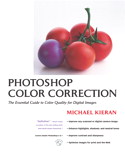Essentials of Photoshop Color Correction: Applying RGB Curves

Peachpit Press is offering this book at a discount to creativepro.com readers. Follow this link.
It’s time to graduate to the big leagues — Curves! (If you need a refresher course, read the “Essentials of Photoshop Color Correction: Curves” sidebar.)
The original image of canoeing the rapids appears dark and flat from underexposure. The first step in correcting it is to identify the highlight and shadow areas and to measure their original RGB values (see “Essentials of Photoshop Color Correction: Highlights and Shadows“). Once you’ve corrected hundreds or thousands of images, you’ll usually be able to find the highlight and shadow points instinctively, using the Info palette just to confirm or refine your selection.
But as you’re learning, it’s best to use the Levels dialog box (or alternately, the Threshold dialog box) to find these crucial areas, monitoring the Info palette as you drag around each area to find the very lightest or darkest points. The Image > Adjustments > Threshold command offers similar functionality, but without the ability to see what’s being clipped in each channel. To follow along step by step, download the canoe image (below) to your machine: Right+Click the image (Windows) or Opt/Control+ Click the image (Mac).


Figure 1: The original photo of the canoeist is too dark due to underexposure. Its histogram shows that almost all pixels are darker than a midtone, and there are no pixels lighter than a quartertone. This image will require severe curves to remap tonal values, but care must be taken to avoid banding.
In the canoeing image, the Levels command shows that the lightest areas are in the whitecaps of the water above the canoe and just to the right of center (with typical values of around 155R 163G 164B), and that the darkest areas are in the rocks in the upper left corner (with typical values around 7R 5G 4B).
With the Levels dialog box open, you can precisely and quickly pinpoint the best highlight and shadow points by zooming in and out using keyboard shortcuts. This saves lots of time.
Press Cmd-0 (Mac) or Ctrl-0 (Windows) to zoom the image to full size; then drag the Levels highlight slider almost all the way to the left, so that the value at the top changes from 255 to 10 or so. Use the Up and Down Arrows on the keyboard to increase or decrease the Levels value, noting how the shadow areas change. The shadow point is normally the darkest area you can find, though there are exceptions for images in which the darkest areas are not supposed to be neutral.
When using the Levels dialog box, take note whenever an image has lots of pixels at very high brightness levels (253 or more on a brightness scale from 0 to 255) or very low brightness levels (3 or less). For instance, an image that has lots of pixels with brightness values of 3 or less is probably exhibiting clipping of the shadows (many pixels are completely or almost black), which suggests that there may have been even darker pixels in the original scene that have not been captured by the digital camera or scanner hardware and software. In such images, the histogram will appear to “hit the wall” in the shadow areas on the left side.
In this case, there are a very few pixels with a brightness value of 5, more with a value of 6, and a lot more with a value of 7, indicating that the image has been captured with a more-or-less acceptable black point.




great article, but frustrating because you suggest we download the canoe image but where the hell is it?
As we have no ftp site from which you can download the .tif file, we simply recommend downloading the JPEG through your usual means. Sorry if we weren’t clear at the outset.
Pamela Pfiffner, editor in chief
Dear Mr. Kieran:
I’m not responding to this article, but your book. At the bottom of page 266 you suggest a small radius value for figure 7-16, because of intricate details. Yet on page 259, at the top, you state images with small details benefit most from high radius settings. I’m confused. Is this a misprint, or can you provide me with more guidance? Thank You, Mitch Miller (PS. great book!)
Great detail, but much of the article is far too wordy.